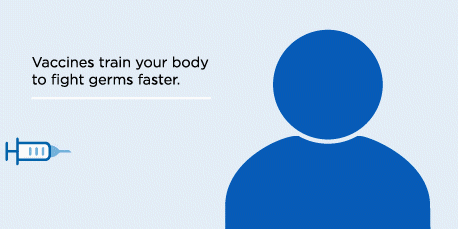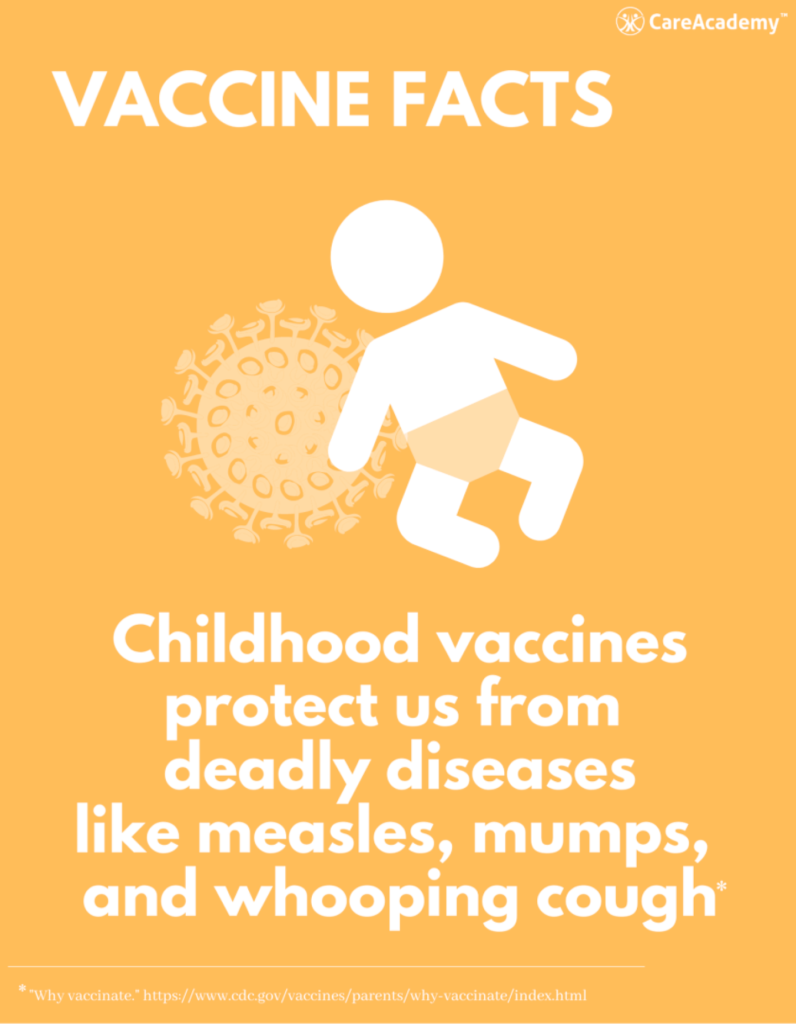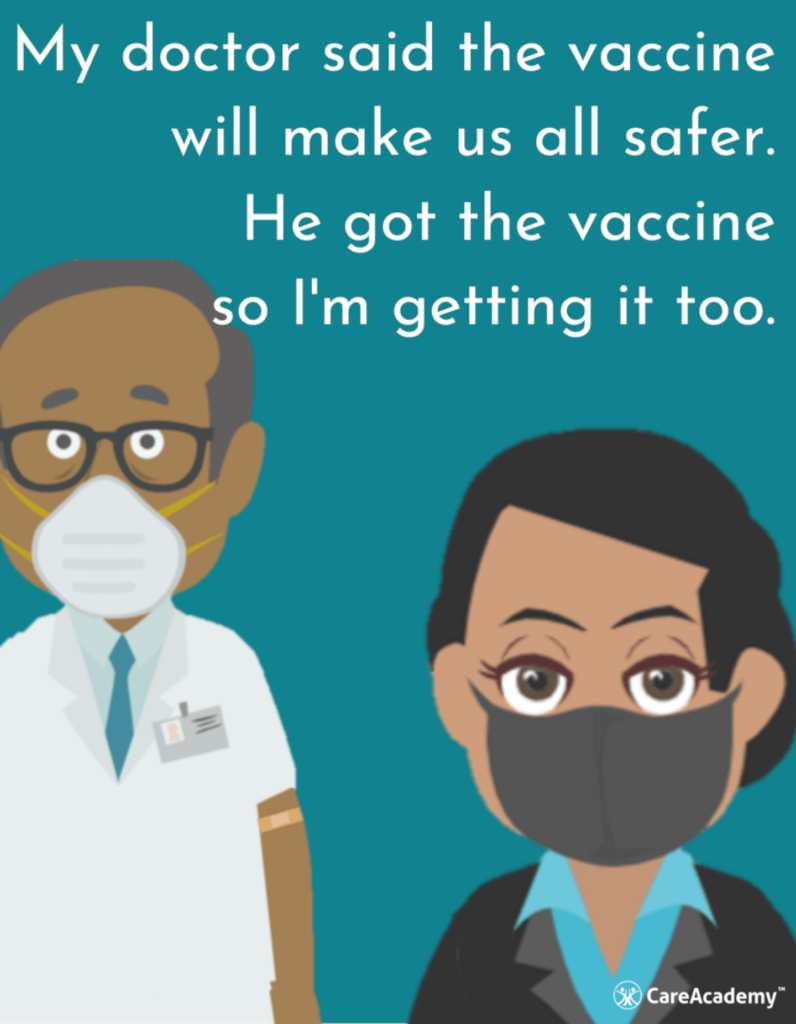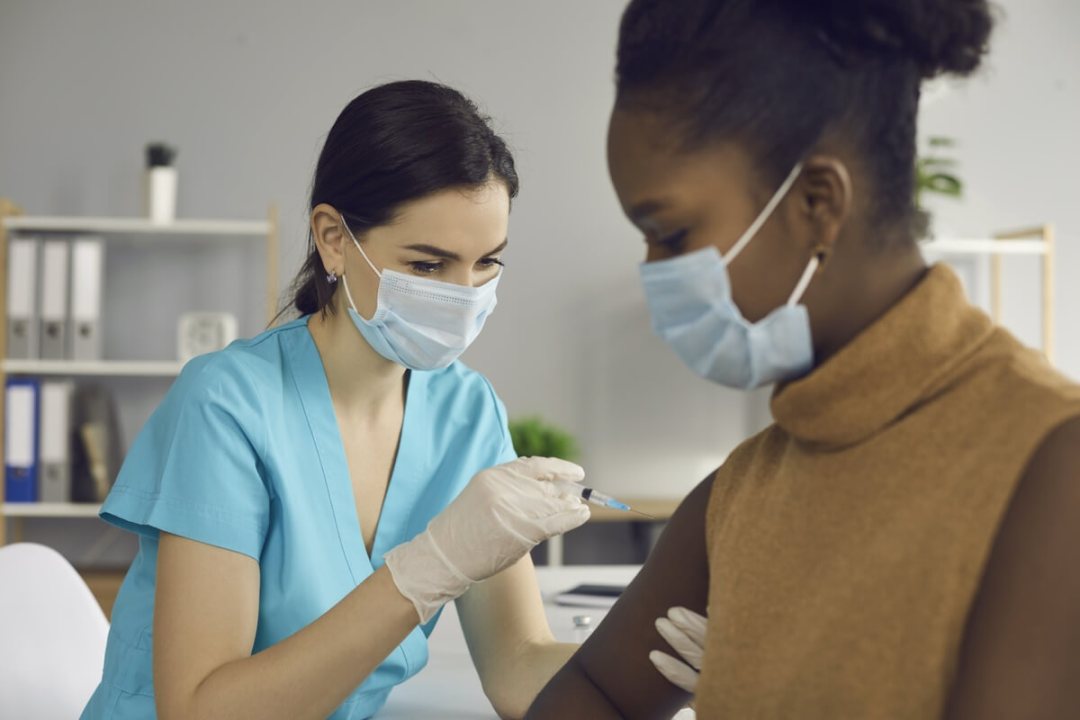Take this quiz to determine whether you are experiencing signs of caregiver burnout, and what to do about it.
Description
CareAcademy’s COVID-19 Vaccine learning resource equips direct care workers to make an informed decision about the vaccine. The material below presents direct care workers (DCWs) with relevant, reliable information about the vaccine and vaccination process.
Learning Objectives
CareAcademy’s COVID-19 Vaccine learning resource equips direct care workers to make an informed decision about the vaccine. The material below presents direct care workers (DCWs) with relevant, reliable information about the vaccine and vaccination process.
Contents
- Why Vaccinations are Important
- Why COVID-19 Vaccinations are Important for Direct Care Workers (DCWs)
- How Vaccines Work
- Addressing DCWs’ Questions, Fears, and Concerns About the Vaccine
- COVID-19 Vaccine Distribution
- How long will it take to get everyone vaccinated?
- Can my employer require me to be vaccinated
- Getting Vaccinated
- Congratulations!
Why Vaccinations are Important - Help Your Loved Ones, Your Clients, and Yourself
You are on the front lines in the fight against COVID-19. Protecting your health also protects the health of your loved ones and your clients. If you become sick and cannot work, you cannot help to support your family, and you cannot provide valuable services for your clients. Many DCWs are at increased risk for catching the disease and having a more severe reaction to it, because of their work conditions, and their race and ethnicity and underlying health conditions.
Precautions are particularly important for DCWs because you work with a high-risk population. Adults over 65, especially those over 80, and individuals with chronic conditions like diabetes and heart disease, are at much greater risk of severe illness or death from COVID-19. You have a responsibility to avoid bringing harm to your clients when you care for them.
The use of appropriate hygiene, PPE, and social distancing are important ways for you to protect yourself and prevent the spread of the disease. The vaccine gives your immune system the ability to fight the virus if you are exposed.
The Centers for Disease Control (CDC) has recommended that health care professionals, including DCWs, be among the first to be offered COVID-19 vaccines. Your agency should have more information about when and where you will have an opportunity to get the vaccine.
How Vaccines Work
The goal of a vaccination is to prevent you from catching a disease. Vaccines are designed by medical experts to help your body’s immune system fight diseases that it has not encountered before.

Each year, millions of people are vaccinated against a number of different diseases, including influenza (flu), measles, mumps, polio, and tetanus. The seasonal flu vaccine (which prevents millions of influenza illnesses and thousands of deaths each year) is about 40-60% effective. In contrast, the COVID-19 vaccines now being distributed in the United States have been shown to be 90-95% effective.

Vaccines are the reason that some diseases that once injured or killed thousands of people no longer exist or have nearly been eliminated. For example, polio was once America’s most-feared disease, because of the death and paralysis it caused. Thanks to vaccination, there are now no reports of polio in the United States.

Many states and local communities require vaccinations for children attending public schools, and each year flu vaccines are recommended, particularly for older adults.
Today, we are in the midst of a global pandemic. Over the past year, COVID-19 has infected more than 100 million people around the world and over 2 million have died. The numbers continue to rise. Needed medical care has had to be postponed because hospitals and health care providers have been overwhelmed by the need to treat patients with COVID-19.
Vaccines are the best way that we have to slow the spread of the disease. Preventing the spread of the disease by being vaccinated will help us get back to normal.

COVID-19 Vaccine Distribution
Who is responsible for distributing the vaccines?
The states are responsible for vaccine distribution. The CDC is working with vaccine manufacturers to make sure the vaccines are distributed to the providers in each state.
Who will get the vaccine and when?
The CDC makes recommendations about who should get the vaccine first, but the states are responsible for vaccine distribution. Each state is making decisions on when different groups will be able to get the vaccine, and when, where, and how the vaccinations will be offered.
Most states have developed a phased approach so that those in essential occupations or who are at greatest risk receive the vaccine soonest. It will take many months, probably into the summer, to vaccinate all those over age 16 who are eligible (up to 150 million people in the United States).
Those who may be eligible in Phase 1 include:
- Health care workers
- Long term care facilities, rest homes and assisted living facilities
- Emergency medical services, police, and fire
- Home-based care workers
- Workers in correctional institutions
- Teachers and other K-12 school personnel
Those who may be eligible in Phase 2 include:
- Individuals age 75+
- Individuals age 65+, individuals with two or more comorbidities (such as diabetes, heart disease, COPD, obesity)
- Residents and staff of low income and affordable senior housing
- Employees across the food, beverages, agriculture, consumer goods, retail, and foodservice sectors
- Sanitation, public works and public health workers
- Water and wastewater utility staff
- Court system workers (judges, prosecutors, defense attorney, clerks)
Phase 3 will make members of the general public between the ages of 16-65 eligible
Your state may require documentation of your status as a DCW if you are eligible to be vaccinated in Phase 1.
Why is vaccine distribution so complicated?
Vaccine distribution is a complex process and the rollout continues to be challenging. There has been no national rollout plan and there is no single administrative body responsible for the entire distribution process.
It has been difficult for states and local communities to manage distribution of the vaccines. In many cases, states, counties and medical facilities are figuring out their own solutions. Difficulties range from not having enough of the vaccine, not having enough trained people to administer the shots, and the challenge of contacting those who may be eligible.
Where and how are the vaccines being distributed?
Each state and locality is working to provide vaccines as widely as possible. This means that public spaces may be put to use as vaccination centers. High school gymnasiums, supermarkets, stadiums, and theme parks may be used, as well as doctors’ offices and mobile clinics.
In time, pharmacies may offer the COVID vaccine shots, as they now do with flu vaccines. The federal government is partnering with some chain pharmacies including CVS and Walgreens, to distribute vaccines, beginning with residents of nursing homes.
The best way to find out where and how vaccines are being distributed in your state or community is to check your state’s health department website.
You may be able to sign up for an appointment on your state or local health department website. Some localities are offering vaccinations at large venues on a first-come, first-served basis.
If you are eligible to be vaccinated, your agency may be able to provide you with assistance to find a suitable provider.
How much does the vaccine cost?
The vaccine doses have been purchased with U.S. taxpayer dollars and are being given to the American people at no cost. However, the vaccination provider who administers the shot may charge an administration fee. That fee should be reimbursed by your health insurance. For anyone uninsured, the fee should be covered by the Health Resources and Services Administration’s Provider Relief Fund. No one can be denied a vaccine if they are unable to pay the vaccine administration fee.
If you are concerned about hidden or unexpected fees, get your vaccine at a health department vaccination site or a local pharmacy, if they offer them.
How long will it take to get everyone vaccinated?
Manufacturing very large quantities of vaccines takes time. In the United States, the government is getting the vaccine from manufacturers, Pfizer-BioNTech and Moderna. Their vaccine requires two doses (shots) to be fully effective. They have pledged to deliver 200 million doses by the end of March, with another 100 million doses by the end of July. A third vaccine maker, Johnson & Johnson, who have developed a single-dose vaccine, may be able to deliver over 20 million doses by the first week in April.
The Biden administration wants to vastly expand vaccination centers and hire 100,000 health care workers to speed things up. The President said that he expects there to be enough vaccines to vaccinate 300 million Americans by the “end of the summer, beginning of the fall.”
Can my employer require me to be vaccinated?
There is no federal requirement that anyone be vaccinated for COVID-19. A state, local government, or employer may require healthcare workers or essential employees be vaccinated. Check with your employer to see what rules may apply to you.

Getting Vaccinated
If you are eligible for the vaccine, you can make an appointment to be vaccinated.
Make an Appointment
The process for making an appointment differs from state to state. Check your state’s health department website to learn the process for your state. As mentioned above, your agency may be able to assist you in finding a suitable provider. When making the appointment, you may be asked to confirm that you are eligible to receive the vaccine.
Attend Your Appointment
Similar to other in-person appointments, stay at least 6 feet apart from others while you are inside and waiting in lines. Both you and the person giving the vaccine will need to wear a facemask. The vaccine will be administered in your arm.

What Happens After Receiving the Vaccine?
Review the section below to learn what to expect after being vaccinated, recommendations for daily life, and how to monitor yourself.
View the video to learn about potential side effects, tips to address side effects, and other things to monitor.
After being vaccinated, you should be monitored for at least 15 minutes on-site. You should be monitored for at least 30 minutes if you previously had a severe allergic reaction or an immediate allergic reaction to a vaccine.
You should receive a card or printout that states:
- Which vaccine you received
- The date you received the shot
- The location where you received the shot
You should also get a card or printout that reminds you when you should return for the second shot. The process for scheduling your appointment for your second shot varies by location. Before you leave, ask about the process for making your second appointment.
Get Your Second Shot
The currently approved vaccines from Pfizer-BioNTech and Moderna require two shots. The first shot of the vaccine helps to teach your body how to defend against the virus. The second shot helps strengthen the immunity. You will need to get the same brand for both shots.
If you experienced side effects from the first shot, get the second shot unless your doctor or vaccination provider has directed you not to.

Timing for the Second Shot
For the Pfizer-BioNTech vaccine, you should receive your second shot 3 weeks after your first shot.
For the Moderna vaccine, you should receive your second shot one month after your first shot.
You can receive your second shot any time after the recommended interval. You should not get a second shot before the recommended interval.
Remember, you are not immediately protected after getting your second dose. It may take a week or two before your body can effectively prevent infection.
Continue Taking Recommended Precautions
Even after being vaccinated, it’s important to continue taking all recommended precautions to prevent COVID-19 infection. The vaccine has been proven to help prevent COVID-19 infection. However, we still don’t know if the vaccine prevents transmission of the virus.

It’s still important to:
- Wear a mask
- Maintain a distance of at least 6 feet from others who don’t live with you
- Wash your hands frequently
- Avoid crowds and large gatherings
- Avoid spaces with poor ventilation
- Avoid unnecessary travel
Monitor Yourself
After being vaccinated, continue to keep a close eye on your health. Contact your doctor or health care provider if:
- Your side effects do not go away after a few days
- The soreness or redness where you got your shot increases after 24 hours
- Your side effects are worrying you
Consider using v-safe. V-safe is a tool on your smartphone that checks in on your health after you’ve received the COVID-19 vaccine. You will receive text message reminders to complete health check-ins. Using v-safe, you can quickly and easily report any side effects. Depending on your answers, someone from the CDC may reach out to you.
Your information will stay secure and private. Participating in v-safe helps keep COVID-19 vaccines safe. Get more information about v-safe and install the tool at vase.cdc.gov.
Congratulations!
Thank you for completing this learning resource on the COVID-19 vaccine. The vaccine is an important tool in helping us all become protected from the virus and ensure our loved ones stay safe!
Share this resource with your co-workers using the links below to help them be better informed about the vaccine.
Join our Facebook Caregiver Community!

This Facebook group was created to allow you to feel supported by a whole community where you can share stories, experiences, resources and more to help support each other!
Review the sources used to create this material and to get additional information on the COVID-19 vaccine.
- 11 Facts About Vaccines. DoSomething.org. https://www.dosomething.org/us/facts/11-facts-about-vaccines.
- Be Wise, Immunize. Resources. Be Wise, Immunize. https://bewiseimmunize.com/resources.
- Centers for Disease Control and Prevention. (2019, August 1). Why Vaccinate. Centers for Disease Control and Prevention. https://www.cdc.gov/vaccines/parents/why-vaccinate/index.html.
- Centers for Disease Control and Prevention. (2020, November 24). Understanding and Explaining mRNA COVID-19 Vaccines. Centers for Disease Control and Prevention. https://www.cdc.gov/vaccines/covid-19/hcp/mrna-vaccine-basics.html.
- Centers for Disease Control and Prevention. (2021, January 11). What to Expect after Getting a COVID-19 Vaccine. Centers for Disease Control and Prevention. https://www.cdc.gov/coronavirus/2019-ncov/vaccines/expect/after.html.
- Centers for Disease Control and Prevention. (2021, January 21). Interim Clinical Considerations for Use of mRNA COVID-19 Vaccines. Centers for Disease Control and Prevention. https://www.cdc.gov/vaccines/covid-19/info-by-product/clinical-considerations.html.
- Centers for Disease Control and Prevention. (2021, January 22). COVID-19 Vaccines and Allergic Reactions. Centers for Disease Control and Prevention. https://www.cdc.gov/coronavirus/2019-ncov/vaccines/safety/allergic-reaction.html.
- Centers for Disease Control and Prevention. (2021, January 25). Frequently Asked Questions about COVID-19 Vaccination. Centers for Disease Control and Prevention. https://www.cdc.gov/coronavirus/2019-ncov/vaccines/faq.html.
- Centers for Disease Control and Prevention. (2021, January 27). V-safe After Vaccination Health Checker. Centers for Disease Control and Prevention. https://www.cdc.gov/coronavirus/2019-ncov/vaccines/safety/vsafe.html.
- Centers for Disease Control and Prevention. (2021, January 28). Facts about COVID-19 Vaccines. Centers for Disease Control and Prevention. https://www.cdc.gov/coronavirus/2019-ncov/vaccines/facts.html.
- Centers for Disease Control and Prevention. (2021, January 28). New Variants of the Virus that Causes COVID-19. Centers for Disease Control and Prevention. https://www.cdc.gov/coronavirus/2019-ncov/transmission/variant.html.
- Centers for Disease Control and Prevention. Frequently Asked Questions about COVID-19 Vaccination. Centers for Disease Control and Prevention. https://www.cdc.gov/coronavirus/2019-ncov/vaccines/faq.html.
- COVID-19 vaccinations for health care workers. Mass.gov. https://www.mass.gov/info-details/covid-19-vaccinations-for-health-care-workers.
- Dept. of Public Health. How to prepare for your COVID-19 vaccine appointment. Mass.gov. https://www.mass.gov/guides/how-to-prepare-for-your-covid-19-vaccine-appointment.
- Graphics. Vaccines. https://www.vaccines.gov/get-involved/spread-the-word/graphics.
- MediLexicon International. COVID-19 vaccine: How was it developed so fast? Medical News Today. https://www.medicalnewstoday.com/articles/how-did-we-develop-a-covid-19-vaccine-so-quickly.
- The New York Times. (2021, January 27). Answers to All Your Questions About Getting Vaccinated for Covid-19. The New York Times. https://www.nytimes.com/interactive/2021/well/covid-vaccine-questions.html.
- The New York Times. (2021, January 27). Answers to All Your Questions About Getting Vaccinated for Covid-19. The New York Times. https://www.nytimes.com/interactive/2021/well/covid-vaccine-questions.html.
- Photo: Douglas R. Clifford/Tampa Bay Times/Zuma Press, Photo: Ringo Chiu/Zuma Press, Photo: Seth Wenig/Associated Press, Photo: Bob Daemmrich/Zuma Press, & Photo: lindsey wasson/Reuters. (2021, January 27). How to Get a Covid-19 Vaccine: a State-by-State Guide. The Wall Street Journal. https://www.wsj.com/articles/how-to-get-a-covid-19-vaccine-a-state-by-state-guide-11611703769.
- Smith, A. (2021, January 31). Covid vaccines: Rollout in disarray in U.S. and abroad. NBCNews.com. https://www.nbcnews.com/news/world/covid-vaccines-rollout-disarray-u-s-abroad-n1256144.
- Who should and shouldn’t get the COVID-19 vaccine?: Yale Health. Who should and shouldn’t get the COVID-19 vaccine? | Yale Health. https://yalehealth.yale.edu/who-should-and-shouldnt-get-covid-19-vaccine.
- World Health Organization. (2011, March 4). No vaccine for the scaremongers. World Health Organization. https://www.who.int/bulletin/volumes/86/6/08-030608/en/.
- Wu, K. J. (2020, December 17). No, there are no microchips in coronavirus vaccines. The New York Times. https://www.nytimes.com/2020/12/17/technology/no-there-are-no-microchips-in-coronavirus-vaccines.html.
- Wu, K. J. (2020, June 15). Study Finds 1 in 5 People Worldwide at Risk of Severe Covid-19. The New York Times. https://www.nytimes.com/2020/06/15/health/coronavirus-underlying-conditions.html.





